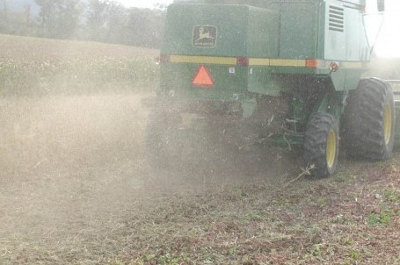By Sjoerd Willem Duiker
Corn and soybean harvest season is here. With the recent rainfall the threat of soil compaction is real. What can you do to avoid soil compaction?

The threat of soil compaction during corn and soybean harvest is high thanks to recent rainfall.
The entire state was blanketed with 1.5-2.5 inches of rain last week while much of the corn and soybean crops still stand in the field. With the dry weather in the forecast harvesting will be in full gear in the coming days. This is the perfect storm to cause soil compaction with the grain cart and the combine. Soil compaction has long-lasting effects and its threats have increased due to the continuously increasing size of farm equipment. Equipment can cause surface compaction (<12”) and subsoil compaction (>12”). Soil compaction reduces total pore volume by compressing the larger pores in the soil. This leads to higher bulk density and increased penetration resistance. Effects are reduced water infiltration capacity, reduced aeration, and increased penetration resistance. The implications are reductions in root growth of following crops, increased runoff, increased nitrogen losses due to denitrification and ammonia volatilization, reduced uptake of immobile nutrients such as phosphorus and potassium, and eventually, reduced yields. Surface compaction effects are the most detrimental in the immediate future, but they don’t last as long as the smaller reductions in soil function due to subsoil compaction. This is the result of more biological activity and freeze-thaw and wet-dry cycles in the surface soil than in the subsoil. The aim of soil compaction management is therefore to eliminate subsoil compaction and reduce surface compaction as much as possible. You can make your soil resist surface compaction by using soil health-improving practices such as no-tillage, maintaining living root systems in the soil as much of the year as possible, and building organic matter content. But there is a limit to what even the most healthy soil can sustain, and therefore a farmer should do what is possible to avoid causing compaction. Here are some tips:
- Evaluate your soil types and field position and harvest the fields with lighter, drier soil first. For example, if you have sandy, shale, and limestone soil on the farm, you could harvest the sandy and shaley fields first. Higher-laying fields or those on south-facing slopes would be the first candidates to be harvested because they dry out faster.
- Reduce as much as possible the area that is trafficked. It is advised to create traffic lanes instead of running all over the field. Companies are coming out with new GPS software systems that can be used to manage field traffic better, such as Machine Sync or AutoTracTM from John Deere. If possible, you could unload when the combine reaches the edge of the field where the truck is parked.
- Don’t take dump trucks and tractor trailers with road tires inflated to 95-105 psi into the field but park them at the field edge. These vehicles have a very small footprint and cause high surface soil compaction.
- Increase combine, tractor and grain cart footprint by reducing tire inflation pressure to the lowest allowable pressure or use tracs. The big selling point of modern farm tires is that they can be run at low inflation pressures, thus increasing their footprint and reducing the pounds-per-square-inch contact stress that causes surface soil compaction. For example, Michelin Very High Flexion (VF) Axiobib tires can run at pressures as low as 9 psi. Michelin has a tire inflation tool that helps you determine the correct inflation pressure for their tires: Michelin Calculate the Right Pressure by Machine. The same can be achieved by using tracs. Suspended trac systems are now available for combines that can help reduce surface contact pressure. For example, the average ground pressure under an S780 JD combine with tracs is 14 psi with a full-grain tank and 616C StalkMaster™ header.
- Use four-wheel drive instead of two-wheel drive tractors and combines. This helps to improve traction and reduces slip that results in soil structure destruction and smearing.
- Reduce axle loads as much as possible, especially when soils are wet. This can be achieved by using smaller grain carts, grain carts with multiple axles, or not loading the combine or cart as full. This may not be a viable option but is just something to consider. Managing axle load is really the only way to reduce the threat of subsoil compaction.
Companies are coming out with new technologies to manage compaction that are not readily available yet in Pennsylvania to my knowledge. One interesting technology is Central Tire Inflation systems. It has been a challenge to change tire pressure on tractors, harvesters, and combines to accommodate changing applications. Central Tire Inflation systems allow you to change the pressure of the tires from the cab and allow you to take better advantage of tire capacities to reduce soil compaction. Another interesting new technology is the PneuTrac tire concept from companies like Mitas and Trelleborg that helps increase the tire footprint beyond what is possible with other tire technologies. Further, the development of robotic farm equipment might reverse the trend towards larger farm equipment because you can now use it 24 hours a day. This could help reduce axle load which is a continuing problem with the currently increasing size of farm equipment.
Source : psu.edu